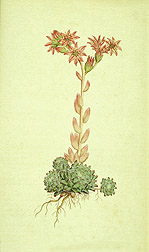Forum—Your National Agricultural
|
|
|
With only a few clicks of your computer mouse, the flower-filled pages from the earliest editions of a British gardening journal will blossom on your screen. These beautiful watercolors, along with the informative text that accompanies them, give today's gardeners and scholars a glimpse of what was known in the period 1787 to 1807 about hundreds of flowering plants. Collected from around the world, the plants were chosen for the publication because they could be grown in British flowerbeds, borders, or glasshouses. Editions of this important journal, Curtis's Botanical Magazine, are one of the many historical treasures preserved and safeguarded at America's National Agricultural Library, located in the Washington, D.C., suburb of Beltsville, Maryland. An article beginning on page 10 tells more about this interesting, informative periodical. Because the library is operated for the benefit of all Americans, every citizen can come here—by weekday appointment—to read and enjoy this interesting journal. For everyone who can log onto the Internet, we've made illustrations and key text from the oldest, most coveted editions available for viewing at http://www.nal.usda.gov/curtis. Curtis's Botanical Magazine is one of many outstanding collections at the library, some with documents that date back to the 1600s. Through purchases, donations, and exchanges, we obtain other historic periodicals, as well as early books, journals, letters, paintings, and photographs. At the same time, we continue to acquire—or develop in-house—new materials in an array of formats. We make this information available to researchers, students, and other library users so that they can keep up with the latest findings in agriculture and related fields, from agronomy to zoology. We provide rapid access to the best knowledge in the traditional agricultural sciences as well as in newer fields like bioinformatics, genomics, and proteomics. Right now, the National Agricultural Library manages more than 3.5 million items of information. But you don't necessarily need to be here in Beltsville to make use of them. No matter where you live in the United States, if you need a copy of an agricultural journal article, for instance, your local library can obtain it for you from the National Agricultural Library for a nominal fee. And we are making more and more content available electronically at no cost on the World Wide Web. The library hosts some 40,000 web pages, with more launches every month. Our web pages are colorful, easy-to-navigate sources of reliable, timely information. In all, our web sites attract more than 16 million visits a year. That means the library is not just a museum of books; it is a vital, active gateway to agriculture and its many sciences. We also offer innovative services. The registered dietitians and other professionals who staff our Food and Nutrition Information Center, for example, compile detailed bibliographies and prepare authoritative fact sheets, reports, brochures, and bulletins. What's more, they post answers to frequently asked questions about food, nutrition, food safety, and more on the center's popular web site. In addition, center specialists provide—on the site—details about other useful sources such as videotapes, CD-ROMs, and manuals. Plus, they list links to hundreds of other web sites in relevant subject areas. The Food and Nutrition Information Center is one of six Internet-oriented centers we have created to rapidly respond to the changing needs of target audiences. The other five information centers focus on water quality, animal welfare, alternative farming systems, rural revitalization, and technology transfer. Each provides quick connection to comprehensive, science-based information in its specialized area. Visitors to center web sites are from community, agricultural, or environmental organizations; small and large businesses; libraries; colleges and universities; and professional associations. Our center staffs are carefully structured to provide expertise not only in library and computer sciences, but also in agronomy, biology, forestry, plant physiology, or other disciplines. The National Agricultural Library was founded—along with U.S. Department of Agriculture—in 1862. Today, as one of America's four national libraries, we manage the world's largest and most accessible compilation of agriculture-directed learning. We continue to pioneer new technologies that will add to the depth of our collection and improve the immediacy with which it is available. Visit us soon on the World Wide Web at http://www.nal.usda.gov, or work with us in person, by appointment, at 10301 Baltimore Avenue here in Beltsville. Discover watercolors, web sites, and the wonderful range of services and knowledge available from your National Agricultural Library. Peter R. Young |
|
| "Forum" was published in the September 2002 issue of Agricultural Research magazine. |







